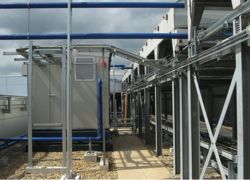A renaissance for ammonia

Two packaged ammonia chillers provide air conditioning for buildings at the 21 800 m2 headquarters of Roche Products at Welwyn Garden City. They are on installed on a roof and have air-cooled condensers. Each chiller has a cooling capacity of 930 kW.
With the use of many refrigerants coming under environmental pressure, attention is being focused on ammonia for air-conditioning applications. ROB LAMB explores the issuesIn recent years ammonia chillers have been shown in numerous installations to be a viable alternative in a building-services environment. Ammonia systems can significantly improve reliability and energy efficiency compared with standard chiller arrangements. Ammonia chillers are also suitable for environments with constraints such as noise or space, which necessitate the design of a special cooling package. Ammonia is not, however, the correct choice for all applications. A number of design and environmental issues need to be considered before selecting ammonia, and guidelines must be followed when incorporating the chillers into the building.
Long history Anhydrous ammonia has been used as a refrigerant since 1872. However, towards the end of the 20th century its use was increasingly limited, being generally restricted to large industrial systems. From 1950 and 1985 it was not used in air-conditioning applications, being displaced by equipment which was cheaper to install and easier to maintain. It might be thought that concerns about safety would feature highly in the decision to avoid ammonia, but it seems that cost and convenience were more important factors. The threat of a phase-out of CFCs as refrigerants prompted a re-evaluation of ammonia as an alternative to HFCs in the early 1990s. When the CFC phase-out was coupled with a ban on new HCFC equipment, which was completed in Europe in 2000, there was a sharp increase in the installation of ammonia chillers. Continuing political pressure in some parts of Europe on the use of fluorocarbon refrigerants has led to a re-evaluation of ammonia in applications previously beyond the scope of this otherwise excellent refrigerant. Ammonia has an extremely high latent heat (1260 kJ/kg at 0°C) and a very high critical temperature (133°C) — making it much more suited to efficient chilling without the addition of liquid line heat exchangers. It has been suggested that ammonia chillers are less efficient than those using R134a as refrigerant. Careful analysis of their respective performance maps has shown that this is not the case, indicating instead that a typical ammonia system will be up to 20% more efficient than one using R134a on an integrated part load value (IPLV) basis.
Care Ammonia chillers are not simple substitutes for fluorocarbon chillers. If used they must be positioned and installed with care. This can cause difficulties for building-services designers who have become accustomed to the flexibility of location offered by traditional chillers, but it is also noted that requiring a building designer to give consideration to equipment access and maintainability is no bad thing. The European Standard on Refrigeration Safety & the Environment, EN378:2000, places some constraints on the ways in which ammonia plant can be used and the locations in which it can be placed. Ammonia is classed as a B2 refrigerant (toxic and mildly flammable), so access to ammonia plant must be restricted to authorised personnel. Chillers must be placed in a machinery room or outside the building in an area where access is restricted. In comparison with standard HFC chillers, ammonia systems tend to be of heavier construction and use industrial components. This can cause issues with noise and vibration, particularly if reciprocating compressors are used, especially for rooftop locations. There are three considerations when designing chiller installations for noise and vibration —maintenance engineer, building occupants and neighbours. Construction of a sufficiently heavy plantroom wall will prevent this airborne noise from travelling to the building occupants, but attention must also be paid to noise breakout through doors, ventilation ductwork or poorly sealed penetrations for pipework.
Noise Transmission of noise to neighbours is very likely to be airborne. The main source will be the condensers, which can be treated in exactly the same way as for traditional chiller plant, either by selecting low-speed fans coupled with larger coil areas, or by adding attenuation. For rooftop mounted plant with screw compressors an attenuated housing will also be required in sensitive areas, bearing in mind the possibility of airborne noise breaking back into the building as well as reaching the neighbours. In conclusion, care must be taken in the early design stages to ensure that the hazards associated with ammonia are designed out of the installation. Chiller location, heat-rejection equipment and emergency arrangements are key aspects. The use of industrial-style equipment in a commercial building requires particular attention to structural support, acoustic treatment and vibration isolation.
Beneficial Overall, the use of ammonia offers beneficial possibilities in the effective, reliable and efficient operation of the plant. However, the greatest energy savings are still made when air-conditioning loads are minimised and chillers are not run unnecessarily.
Rob Lamb is sales director with Star Refrigeration, Thornliebank Industrial Estate, Glasgow G46 8JW.
Related links:








